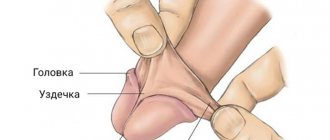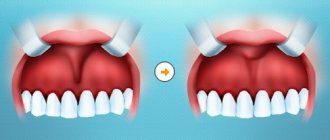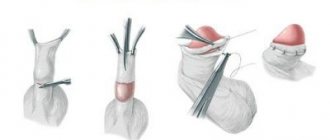Plastic surgery of the frenulum under the tongue is an operation to cut this fold, which is most often performed in a child, but can also be performed in adults. You can trim the frenulum at the Smile dental clinic in Ivanovo. The surgery is performed painlessly with minimal risk of complications. The operation does not take much time and significantly improves the quality of life of patients. At Smile Dentistry, plastic surgery is performed by qualified dentists using modern equipment. Make an appointment to find out whether surgery is necessary and its exact price.
How to understand whether a tongue frenulum is short or not?
Determining frenulum shortening is quite simple even in newborns. Their feeding process is disrupted and weight loss may occur. But in some cases, incorrect attachment of the frenulum is detected in an adult.
| Signs of a shortened frenulum | Indications for surgery |
| • Restricted mobility of the tip of the tongue • The tongue curls into a tube with a clicking sound • Impaired pronunciation of certain sounds | • Quick tiredness of the mouth when chewing and talking • The area under the tongue hurts when it moves too sharply • Malocclusion • Displacement of the gums • Curvature of the smile, violation of facial proportions • Disturbance of normal breathing |
Specialists at the Smile clinic will conduct a comprehensive examination of the client and determine whether there are indications for surgery, eliminating contraindications. Doctors guarantee the safety of patients and take care of their comfort.
Short frenulum of the tongue in a child
Ankyloglossia in children can cause problems with feeding, development of speech function, and development of the dental system. The severity of functional disorders in a child with a short frenulum of the tongue depends on the length and elasticity of the ligament, the place of its attachment, the length and flexibility of the free edge of the tongue.
Difficulties with breastfeeding occur in a quarter of children with a short frenulum of the tongue. In this case, the baby cannot properly latch onto the breast with his mouth, which is why the nipple latch constantly worsens or repeatedly “loses” the breast during feeding. During sucking, characteristic sounds of clicking (clicking) of the tongue appear, restless behavior, and rapid fatigue are noted. At the same time, during one feeding, the baby sucks out a volume of milk that is insufficient for saturation. The consequence of insufficient nutrition is poor weight gain, and in some cases, malnutrition.
Often mothers note that a child with a short frenulum uses his lips to suck, bites or chews the breast with his gums, compensating for the incorrect position of the tongue and trying to increase pressure on the breast. If the child exerts a lot of tension, due to muscle fatigue, he may experience jaw tremors.
The process of feeding a child with a short frenulum of the tongue becomes tiring for mother and baby, and may be accompanied by pain due to injury and cracks in the nipple. Ineffective sucking leads to lactation problems (hypogalactia) because it does not stimulate milk production. In this regard, a child with a short frenulum of the tongue is often transferred to bottle feeding or artificial feeding.
In some cases, even with a short frenulum of the tongue, the baby sucks correctly and receives a sufficient amount of milk. In such children, an anatomical feature in the form of ankyloglossia may appear at an older age, during the period of formation of speech function. A short frenulum of the tongue in a child prevents the correct articulation of sonors ([p], ([p´], [l], [l´]), plucking ([w], [z], [h], [sch]) and others sounds of upper articulation ([t], [t'], [d], [d']). In speech therapy, this condition is regarded as mechanical dyslalia. With a polymorphic disorder of sound pronunciation, the child’s speech becomes illegible and incomprehensible to others.
A short frenulum of the tongue in a child can cause dental problems: open bite, prognathia, displacement of the dentition, the formation of a diastema between the lower front incisors, the development of gingivitis and periodontitis, exposure of the necks and the formation of dental hyperesthesia.
An older child and teenager with a short frenulum of the tongue may be bothered by a cosmetic defect (V-shaped tip of the tongue), constant tears of the frenulum, excessive salivation during speech, aerophagia, snoring and sleep apnea. This problem can leave a negative imprint on self-esteem and give rise to emotional and behavioral problems that require the intervention of a child psychologist.
How to trim the frenulum under the tongue?
Trimming the short frenulum of the tongue is as follows:
- Local anesthesia
- Excision of a shortened frenulum
- Trimming the mucous membrane adjacent to the frenulum and moving it
- Suturing of the mucous membrane (when performing laser surgery, the operation is seamless)
In children, stretching the frenulum does not cause any problems. After just a couple of hours, the baby can be put to the breast. In adults, surgery is followed by a short recovery period.
How is tongue frenuloplasty performed?
The operation is performed under local anesthesia. The duration of the surgical intervention is no more than 10–15 minutes. During the operation, the frenulum is excised and given the correct position. To perform the operation, the doctor can use both surgical instruments and a laser. In the first case, the wound is sutured. When using a laser, trimming the frenulum is bloodless and no stitches are required.
At the Solnechny Ostrov clinic you can trim the frenulum of the tongue using a laser. We guarantee you exceptional quality of medical procedures, warm welcome and comfortable treatment conditions! We carry out high-quality diagnostics, follow modern treatment protocols and keep up with the times!
Rehabilitation period
Recovery after the procedure takes 3-4 days, and even less when working with a laser. Recommendations during the rehabilitation period:
- Refusal to eat for 2-3 hours after the procedure
- Avoiding hot, spicy, sour foods for several days
- Avoiding hot drinks for a day
- Limiting solid foods while healing
- Rinsing the mouth with antiseptics
- Using healing ointments
The doctor gives detailed recommendations and prescriptions on an individual basis.
Lump under the tongue on the frenulum
In some cases, problems with tongue mobility and the sensation of a foreign body under it are not necessarily related to the size of the frenulum. The fold is of normal length, but a small white ball is found on or near it. This is how the inflammatory process in the mouth manifests itself. However, the presence of a shortened frenulum, on which food debris accumulates, significantly increases the likelihood of developing an infection.
If a lump appears under the frenulum, you need to contact your dentist to accurately determine the cause and effectively eliminate the problem. If necessary, after treatment of inflammation, fold plastic surgery is performed.
Tongue frenulum and its meaning
The frenulum connects the tongue to the floor of the mouth. Doctors call it the hypoglossal ligament. And the word “frenulum” apparently expresses the role of this fold: it actually holds the tongue when it rises up. A frenulum is needed to prevent the baby's tongue from falling back during periods of intense crying. Normally, the ligament should be located in the center of the tongue and reach the base of the gums of the lower incisors. However, it often turns out to be too short: it does not come from the center of the tongue, but from the very edge. In this case, the tongue is not able to move freely in the mouth. Typically, such a physiological abnormality is associated with heredity.
Patient reviews
“All my life I suffered from speech disorders, I even went to a speech therapist, but I didn’t achieve much effect. Besides, I have a slightly incorrect bite. I didn’t understand what the problem was, but in the end, at a dentist’s appointment, a shortening of the frenulum was discovered. It was quickly trimmed and after a few days I noticed how much easier it became to talk and even eat. Thank you very much to the doctors of the clinic!” Vladislav, 28 years old
“After the birth of the child, I almost immediately realized that he could not moisten milk normally. I was very scared, you never know what kind of disease could manifest itself. But a small frenulum was quickly discovered and plastic surgery was performed. And now there are no problems. Thank you very much!" Alina, 25 years old
“Thank you to the doctors for the quick and painless operation. I am always afraid of any interventions, but here they did it very carefully, without discomfort. Very pleased with the service and results.” Svetlana, 40 years old
Conclusion: Trimming a shortened frenulum of the tongue is a fairly simple operation that does not take much time. It is necessary at any age to restore normal functionality of the oral cavity. Sign up for a consultation at the Smile clinic in Ivanovo for a comprehensive examination and pain-free manipulation.
Consultation with a speech therapist teacher “Hyoid frenulum: trim or stretch?”
Evgenia Kovalevskaya
Consultation with a speech therapist teacher “Hyoid frenulum: trim or stretch?”
“Hyoid frenulum: trim or stretch?”
The sublingual frenulum is a membrane that is located under the tongue and connects the tongue to the sublingual space.
How to determine whether the hyoid frenulum is long enough?
The hyoid ligament (frenulum) can be of different lengths in different people.
Ask your child to lift his tongue up toward the hard palate. With a normal hyoid frenulum, the child freely raises the tongue to the hard palate. With a short hyoid frenulum, the child cannot stretch the tongue forward and lift the tongue upward towards the hard palate. When the child pulls his tongue up, you will see how the hyoid ligament, limiting the rise of the tongue, stretches, becomes more pronounced, protrudes more prominently under the tongue, and becomes thinner. Another reason that a child cannot lift his tongue up is that the child’s tongue muscles are not strong enough and are inactive. Then you will see how he cannot cope with the muscles, then the tongue trembles, deviates to the side, twitches, and goes down.
Normal: at 5 years of age, the frenulum in a stretched state should be at least 8 mm. The average length of the frenulum is 1.5 cm.
What does this mean?
Short hyoid frenulum:
- can cause difficulty in moving the tongue, as it does not allow it to rise high. In this case, the so-called “upper sounds” suffer, i.e. the pronunciation of sounds such as Ш, Ж, Х, Ш, Р, Рь is disrupted
- can lead to a displacement of the center of the tongue, its asymmetrical development and low mobility, which prevents the formation of the correct articulatory posture of some sounds.
- may also cause problems with sound pronunciation
– in some cases, it can provoke problems with the formation of the lower jaw, i.e. the teeth may deviate and the necks of the teeth may be exposed. There is a risk of developing periodontitis and gingivitis. Therefore, a consultation with an orthodontist is necessary.
What to do?
1. Surgery
2. Stretching the hyoid frenulum
Even if the frenulum is somewhat shortened (equal to 8 mm), it is better to stretch it than to operate, since this procedure is somewhat painful and unpleasant for the baby!
Strong indications for trimming the hyoid frenulum:
1. It is better to trim the short frenulum of the tongue at an early age, up to one year.
Indications for surgery if the child while feeding:
• the child sucks poorly at the breast due to the fact that the shortened frenulum prevents the mother from tightly clasping the nipple.
• throws back his head.
• smacks and cries when sucking.
2. At an older age, the indication is when, due to a shortened frenulum, the child’s dentition shifts and an abnormal bite is formed.
3. Difficulties in pronouncing sounds; only in some cases does it require surgical intervention. In 90% of cases, when 1-4 sounds are violated, the short frenulum of the tongue is easily stretched with the help of special articulatory gymnastics exercises.
Methods and techniques for stretching the hyoid ligament (frenulum).
MECHANISM OF EXERCISES for stretching the frenulum: since this is a fold (like a muscular, mucous fold, that is, the ability to carefully and slightly correct the initial state of the frenulum, the exercises give the tongue the opportunity to rise up, thereby gradually stretching the muscle (it is quite elastic, these exercises cannot be performed jerkily, very smoothly and slowly.
Sounds that require a noticeable upward movement of the tip of the tongue ([р], [ш], [ж]) are placed after the child’s hyoid ligament is fully stretched.
Sounds ([l], [h], [sch], [t'], [d']) can be started when the frenulum has not yet fully stretched, but there is already some upward movement of the tip of the tongue.
A short frenulum does not interfere with the normal pronunciation of other sounds of the Russian language.
It is recommended to start stretching the frenulum at an early age. All children are recommended to do gymnastics for the tongue - this will help avoid a lot of problems at 5-7 years old (talking about pronunciation).
Attention! Parents!
Before you start doing exercises to stretch the hyoid frenulum, you need to visit a speech therapist so that he can show you how to do them correctly! Your inept movements can lead to a rupture of the frenulum - and this is terribly unpleasant once, and then a knot twice.
Articulation exercises for stretching the frenulum of the tongue:
1) “Lick the saucer.”
Invite your child, like a kitten, to lick a saucer smeared with jam or something else.
You can reach for the spoon with your tongue.
2) "Swing"
Open your mouth, reach with the tip of your tongue first to your nose, and then to your chin, then again to your nose, and then again to your chin.
5) "Horse"
Smile, open your mouth. Click the tip of your tongue like a horse clicking. The mouth is open, the tongue should be wide. Make sure that the tip of the tongue does not turn inward and that the lower jaw remains motionless.
6) "Painter"
Smile, open your mouth. Using the wide tip of your tongue, stroke the palate from the teeth to the throat. The lower jaw should not move.
7) "Mushroom"
Smile, open your mouth. Suck your wide tongue to the roof of your mouth. This is the cap of the mushroom, and the hyoid ligament is the stalk. The tip of the tongue should not turn up, the lips should be in a smile. If the child is unable to suck his tongue, then he can click his tongue, as in the “Horse” exercise. Clicking trains the desired movement of the tongue.
 "Harmonic"
"Harmonic"
Position the tongue as in the “Mushroom” exercise, lips in a smile. Without lifting your tongue, open and close your mouth.
9) "Drum"
Smile, open your mouth. Repeatedly and clearly pronounce the sound D-D-D. When pronouncing this sound, the tongue rests on the upper teeth, do not close the mouth. Very often, when performing this exercise, the child closes his mouth. To prevent this from happening, you can hold a stick about 1 cm wide or the handle of a rectangular children's toothbrush between your teeth (the handle should not be thick, it should be straight, like a ruler).
10) "Football"
Close your mouth, press the tip of your tongue against one cheek, then the other, so that balls are inflated under the cheek.
11) Exercise “Mole”
Use your index fingers and thumbs to pull your tongue down by the tip.
- There is a slide in the yard, -
Use your index fingers and thumbs to pull your tongue upward by the tip.
— There is a mink under the hill. –
With your index finger, forcefully stroke the hyoid frenulum from bottom to top, stretching it.
- In this hole
— The mole is guarding the mink.









